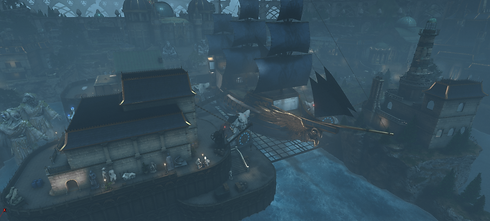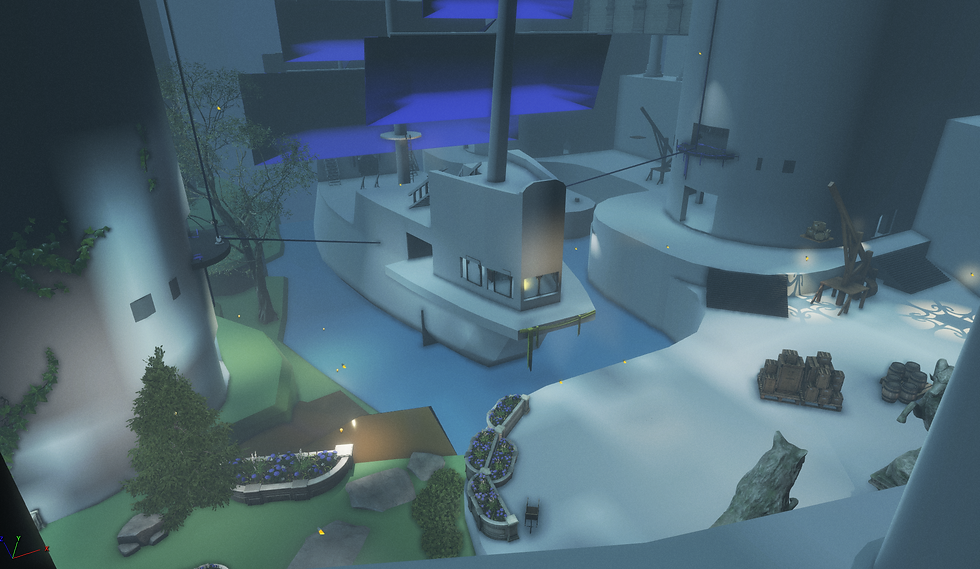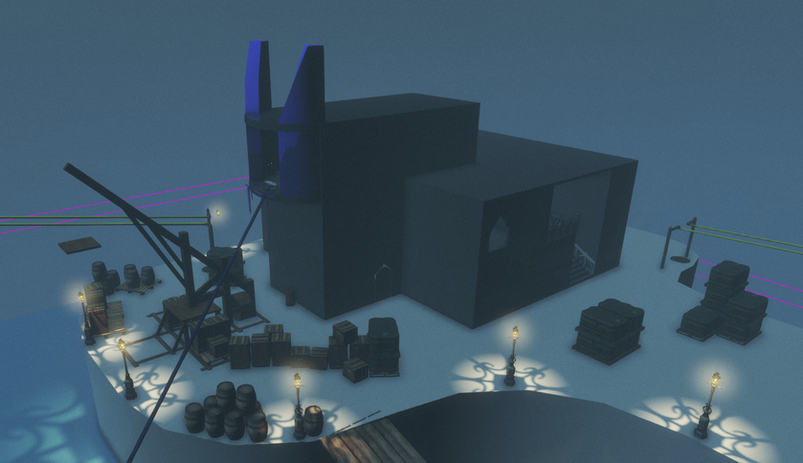
LEVEL DESIGNER || 2025
TACTIC STUDIOS || SQUARE ENIX

WHAT IS KILLER INN?
Killer Inn is a social deduction, murder mystery action game where players are either killers or innocents. Killers must eliminate all innocents to win, and lambs must either escape or eliminate all killers to win.
The core game loop of Killer Inn is to complete quests to obtain loot and experience to become stronger. Then depending on your role, you either start eliminating innocents, or guardians in order to escape.
Killer Inn was made using an in house engine.
MY CONTRIBUTIONS
The final products are the effort of many team members including concept artists, environment artists, audio designers and more.
Levels I designed:
-
Unannounced level
As a team of 40, I was also given the opportunity to work on other aspects of the game including:
-
Lighting
-
Particles & FX
-
Character Dialogue

THE HARBOR
DESIGN GOALS
The harbor is designed to be the final stand between Lambs and Wolves, as this is the final step towards freedom for Lambs. It was created to house approximately 33 players, though the number can vary drastically from game to game depending on how they play out before the harbor is open.
The Harbor is meant to favor Lambs, without making it impossible for Wolves. By placing 6 objectives through the map, it forces lambs to make a choice: split up and risk being taken out 1 by 1, or stay together but risk letting wolves setup an ambush. Because this is the final stand, I wanted all gameplay styles to be viable for two reasons: 1. Players can still play the way they want and thrive and 2. Reduce the chances of certain builds becoming the dominant strategy because they are favorable in every phase of the game.

DESIGN + ITERATION PROCESS
-
Start on paper where I write out any important elements such as setting, story, gameplay requirements and research
-
Sketch out rough concepts, ideas and diagrams
-
Get into the project and test the player controller to gather metrics on what feels good
-
Refine my ideas into a more fleshed out map
-
Take the map to the engine and create a first blockout
Killer Inn worked on a 1 week iteration cycle. Every Friday we would playtest the game for a few hours. I would always have a survey prepared for the end of every playtest that would be optional for everyone to fill out. The surveys would focus on key changes for this iteration and problems yet to be solved. I also love to leave space for any open comments and to ask about players' favorite and least favorite moments at the end even if it wasn’t related to the layout at all. It has created some interesting ideas and pointed out some glaring issues that the survey did not cover!
The following week I will take the data from the playtest and survey to identify what is and isn’t working about the level. I then iterate my designs to tend to these issues while keeping the parts that are working undisturbed, or integrate them into the new layout.



KEY ITERATIONS
The Harbor went through dozens of iterations, but for the simplicity of this post, I will just talk about 3 key iterations that made the Harbor what it is today.

INITIAL BLOCKOUT
The initial blockout for the harbor was 1/3 the size it is now. It was built to house around 9 players. This was a good size for the number of players, but Killer Inn was intended for a different game mode initially. This led to us making the call to expand the map to house 33 players instead.
What worked:
-
The round shape created great loops for players to run, while avoiding players getting lost
-
The ship was a great way to block sightlines across the water
-
This size felt perfect for 9 players, but we decided to house 33 instead.
What didn’t work:
-
The map wasn’t quite large enough for snipers to be a viable option.
-
The smaller size meant the game almost always came down to an elimination victory for one team or the other, and the final objective was rarely completed.
-
The objectives had little to no cover, making them quite difficult to complete without great risk

KEY ITERATION 2
Now the map was significantly larger, and also contained 4 clock towers which were an initial part of our concepts for the final arena. These clock towers were a great opportunity for me to test out more long ranged playstyles, so I created bridges connecting the towers on their respective sides, with strategic openings to shoot through. These proved to be too powerful though, and while it may not have been a dominant strategy, it sure was powerful. This almost always resulted in the sniper being one of the final players alive.
What worked:
-
The new size worked great for ~30 players
-
The clock towers created very interesting structures to climb and fight over.
-
The ship now made for a great aggressive POI.
-
Early arrivals fight on the top of the boat as they enter
-
Late arrivals get to fight inside the boat, moving from cover to cover, and even using lower levels of the ship as flanking routes.
-
-
I added locked rooms scattered across the harbor which contained useful supplies such as health and ammo. These ensure items like the crowbar remained relevant and interesting in the final fight.
What didn’t work:
-
The clock tower all blended into one, making it hard to tell where you were on the map at a glance when inside one of the giant structures.
-
The bridges along the clock towers made for great connections, but made it too easy to stall the game by running away indefinitely.
-
Players did not enjoy falling to their deaths in the water surrounding the boat

FINAL PASS
We decided to cut the towers for both gameplay and aesthetic reasons, bringing me back to some of the structures from the earlier iterations. With more space available I was able to flesh out these structures much more to play as isolated spaces to fight over, where certain strategies could thrive.
What worked:
-
Added a grate that suspends the ship above the water. This removed the death pit now that the gap between the boat and land was so large. It also allowed the possibility to enter the boat from the bottom floor, where I added submarine style doors, enabling flanking and stealth on the ship. A real stowaway!
-
Each POI now had its own identity through aesthetics and gameplay.
-
Each playstyle is now completely viable:
-
The lighthouse enabled sniper gameplay without allowing them to dominate the entire map.
-
The storage facility allows players to hide and ambush behind cover and corners.
-
The ship is a great place for aggressive fire fights, with multiple paths, cover rotations and flanking routes.
-
The armory
-
-
I added vendors and chests to the map, ensuring any unused gold and tokens didn’t go to waste, and giving players another chance to acquire equipment they may need.
-
Spacing between objectives is good. It gives enough time to travel between them that they feel separated, while also allowing for encounters with other players.
-
What still doesn’t work:
-
Due to timing restrictions, the number of players per match changed, resulting in the arena being way too large for the average number of players that actually get to this phase.
-
The limited entry points INTO the harbor bottleneck players quite a bit. One good Wolf could snipe most of the lambs as they crossed the bridge



















